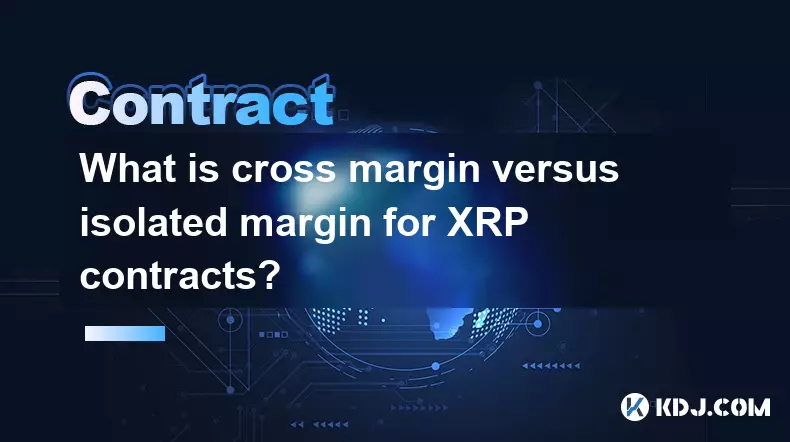-
 bitcoin
bitcoin $123963.239194 USD
1.37% -
 ethereum
ethereum $4529.082464 USD
1.07% -
 xrp
xrp $2.983640 USD
0.71% -
 tether
tether $1.000287 USD
0.02% -
 bnb
bnb $1179.874393 USD
2.99% -
 solana
solana $230.633678 USD
1.55% -
 usd-coin
usd-coin $0.999835 USD
0.03% -
 dogecoin
dogecoin $0.254240 USD
1.34% -
 tron
tron $0.341176 USD
0.15% -
 cardano
cardano $0.842285 USD
0.52% -
 hyperliquid
hyperliquid $48.537896 USD
-0.86% -
 chainlink
chainlink $21.863092 USD
-0.84% -
 ethena-usde
ethena-usde $0.999743 USD
-0.07% -
 sui
sui $3.579561 USD
-0.18% -
 stellar
stellar $0.403418 USD
2.67%
What is cross margin versus isolated margin for XRP contracts?
Cross margin uses your entire account balance as collateral for XRP futures, increasing capital efficiency but spreading risk across all positions.
Oct 06, 2025 at 12:37 am

Cross Margin vs Isolated Margin in XRP Contracts
Trading XRP futures with leverage requires understanding the margin systems that govern risk and capital allocation. Two primary models dominate the landscape: cross margin and isolated margin. Each offers distinct mechanisms for managing exposure, liquidation risks, and fund utilization across open positions.
How Cross Margin Works
- In cross margin mode, all available equity in the trading account acts as collateral for open XRP contracts. This means the entire balance supports active positions, increasing capital efficiency.
- If the market moves against a position, the system draws from the total account balance to prevent immediate liquidation. This buffer can help traders withstand temporary volatility.
- Leverage is dynamically adjusted based on overall account health rather than being fixed per trade. As losses accumulate, effective leverage increases since more of the account is committed.
- Risk is interconnected—losses on one position affect the margin available for others. A sharp move in XRP price can trigger cascading effects across multiple trades.
- This model suits experienced traders who manage multiple positions simultaneously and prefer maximizing usable margin across their portfolio.
Understanding Isolated Margin
- Isolated margin assigns a specific amount of capital exclusively to a single XRP contract position. No other funds in the account are used unless manually adjusted.
- Traders set the leverage and margin amount at the time of entry, creating defined boundaries for potential loss. This simplifies risk calculation.
- Liquidation occurs when the assigned margin is depleted, regardless of the rest of the account’s performance. The remainder of the balance remains untouched.
- This method allows granular control, enabling different leverage levels for different XRP trades without interference.
- It is particularly useful for strategies requiring strict risk compartmentalization, such as hedging or running algorithmic setups with fixed parameters.
Key Differences in Risk Management
- Cross margin spreads risk across the entire account, while isolated margin confines it to individual positions. This distinction shapes how traders respond to adverse price movements.
- In fast-moving markets, cross margin may delay liquidation by using surplus equity, offering breathing room during short-term swings in XRP value.
- Isolated margin provides transparency: traders know exactly how much is at stake and where the liquidation price lies, unaffected by other trades.
- A major drawdown in cross margin can wipe out an entire account if multiple leveraged XRP positions move against the trader simultaneously.
- Isolated margin limits maximum loss per trade but offers no fallback if the allocated funds are insufficient to absorb volatility.
Frequently Asked Questions
What happens to other positions in isolated margin if one XRP contract gets liquidated?Other positions remain unaffected. Each trade operates independently with its own dedicated margin, so liquidation of one does not impact the collateral of another.
Can I switch between cross and isolated margin during an active XRP trade?Most exchanges do not allow switching modes once a position is open. The margin type must be selected before entering the trade and remains fixed until closure.
Does cross margin increase my effective leverage over time?Yes. As losses accumulate in cross margin, the proportion of account equity tied to a losing position grows, effectively increasing leverage even if nominal settings remain unchanged.
Which margin mode is better for high-leverage XRP trading?Isolated margin is generally preferred for high-leverage scenarios because it caps exposure and prevents total account collapse from a single trade failure.
Disclaimer:info@kdj.com
The information provided is not trading advice. kdj.com does not assume any responsibility for any investments made based on the information provided in this article. Cryptocurrencies are highly volatile and it is highly recommended that you invest with caution after thorough research!
If you believe that the content used on this website infringes your copyright, please contact us immediately (info@kdj.com) and we will delete it promptly.
- BlockDAG, DOGE, HYPE Sponsorship: Crypto Trends Shaping 2025
- 2025-10-01 00:25:13
- Deutsche Börse and Circle: A StableCoin Adoption Powerhouse in Europe
- 2025-10-01 00:25:13
- BlockDAG's Presale Buzz: Is It the Crypto to Watch in October 2025?
- 2025-10-01 00:30:13
- Bitcoin, Crypto, and IQ: When Genius Meets Digital Gold?
- 2025-10-01 00:30:13
- Stablecoins, American Innovation, and Wallet Tokens: The Next Frontier
- 2025-10-01 00:35:12
- NBU, Coins, and Crypto in Ukraine: A New Yorker's Take
- 2025-10-01 00:45:14
Related knowledge

What is the difference between futures and perpetual contracts for Bitcoin?
Oct 02,2025 at 11:54pm
Understanding Bitcoin Futures Contracts1. Bitcoin futures are derivative instruments that allow traders to speculate on the future price of Bitcoin at...

What is the best time to trade PEPE contracts?
Oct 03,2025 at 11:54am
Understanding PEPE Contract Volatility1. PEPE contracts exhibit extreme price fluctuations due to their meme-based nature and low market cap. Trading ...

What are the common mistakes to avoid with Bitcoincoin contracts?
Oct 03,2025 at 08:54am
Emerging Trends in the Cryptocurrency Market1. Decentralized finance (DeFi) platforms continue to expand their influence across the blockchain ecosyst...

What is the maintenance margin for Bitcoin contracts?
Oct 02,2025 at 01:36am
Decentralized Exchanges Gain Momentum in 20241. Decentralized exchanges (DEXs) have seen a significant rise in trading volume, surpassing centralized ...

How to use technical analysis for trading XRP contracts?
Oct 03,2025 at 01:18pm
Understanding Price Patterns in XRP Futures1. Identifying chart patterns such as triangles, head and shoulders, and double tops or bottoms can provide...

What does "longing" PEPE contracts mean?
Oct 03,2025 at 11:54pm
Understanding Decentralized Exchanges in the Crypto Ecosystem1. Decentralized exchanges (DEXs) operate without a central authority, allowing users to ...

What is the difference between futures and perpetual contracts for Bitcoin?
Oct 02,2025 at 11:54pm
Understanding Bitcoin Futures Contracts1. Bitcoin futures are derivative instruments that allow traders to speculate on the future price of Bitcoin at...

What is the best time to trade PEPE contracts?
Oct 03,2025 at 11:54am
Understanding PEPE Contract Volatility1. PEPE contracts exhibit extreme price fluctuations due to their meme-based nature and low market cap. Trading ...

What are the common mistakes to avoid with Bitcoincoin contracts?
Oct 03,2025 at 08:54am
Emerging Trends in the Cryptocurrency Market1. Decentralized finance (DeFi) platforms continue to expand their influence across the blockchain ecosyst...

What is the maintenance margin for Bitcoin contracts?
Oct 02,2025 at 01:36am
Decentralized Exchanges Gain Momentum in 20241. Decentralized exchanges (DEXs) have seen a significant rise in trading volume, surpassing centralized ...

How to use technical analysis for trading XRP contracts?
Oct 03,2025 at 01:18pm
Understanding Price Patterns in XRP Futures1. Identifying chart patterns such as triangles, head and shoulders, and double tops or bottoms can provide...

What does "longing" PEPE contracts mean?
Oct 03,2025 at 11:54pm
Understanding Decentralized Exchanges in the Crypto Ecosystem1. Decentralized exchanges (DEXs) operate without a central authority, allowing users to ...
See all articles










































































